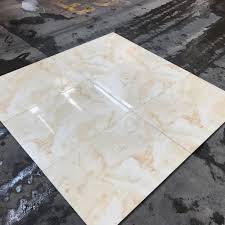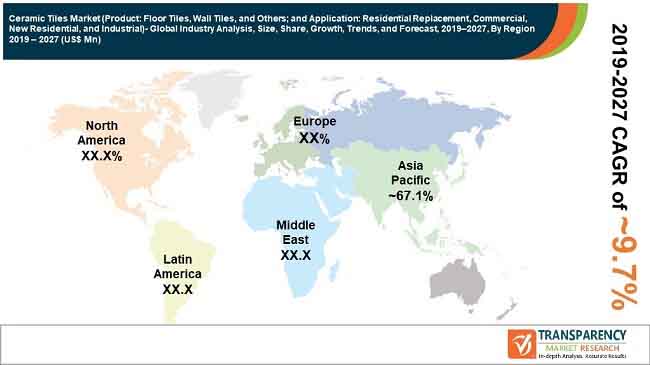
Impact Assessment of COVID-19 Outbreak on Ceramic Tiles Market
Key Highlights:
- In terms of value, the global ceramic tiles market was stood around US$ 88.0 Bn in 2018 and is anticipated to expand at a CAGR of more than 9% from 2019 to 2027
- Based on product type, floor tiles was major product type accounted for more than 50% of the total ceramic tiles in terms of volume and value in 2018. Ceramic tiles are strong, easy to maintain, and cost effective. This makes them an appealing choice over other types of flooring such as vinyl, and wood. Ceramic tiles are available in a wide variety of shapes, colors, sizes, and designs.
- In terms of application, residential replacement was the dominant application accounted for more than 40% of the total ceramic tiles market in 2018. It is likely remain dominant application between 2019 and 2027
- Based on region, Asia Pacific held major share in 2018 and is expected to grow at significant rate of more than 9.0% compared to other region during forecast period 2019 to 2027. Low manufacturing cost, increasing disposable incomes, and rising construction activities in Asia Pacific drive the market for ceramic tiles in the region
Increase in Raw Material Prices and CO2 emissions during ceramic tile production May Hamper Overall Ceramic Tiles Demand
- Major raw materials employed during the processing of ceramic tiles include feldspar, kaolin, bentonite, and silica sand. After the economic crisis of 2008, prices of these raw materials have been increasing across the world
- High consumption of these raw materials in other Application applications (especially glass, thermal and electric insulation, paints, refractories, and food packaging) has led to sharp increase in their prices after 2010. This is anticipated to affect the ceramic tiles market during the forecast period.
- The recent shift toward consumption of these raw materials in other industries (such as feldspar in the production of fiberglass) has led to shortage of raw material supply in the ceramic tiles market to a certain extent
- Presence of a large number of Applications of feldspar, clay, and industrial sand leads to higher demand for these materials. This, in turn, increases their prices
- Various production processes are employed in the processing of ceramic products such as tiles and sanitary ware
- Processing of raw materials such as clay and silica sand results in dust formation and emission of particulate matter and greenhouse gases. Particulate matter and greenhouse gases are emitted primarily during drying, firing, and machining operations during the manufacture of ceramic tiles.
- Emission of carbon dioxide during the manufacture of ceramic tiles is anticipated to hamper the ceramic tiles market during the forecast period
More Trending Reports by TMR:
Asia Pacific Expected to be Highly Lucrative Region of Global Ceramic Tiles Market
- In terms of region, the global ceramic tiles market has been divided into North America, Europe, Asia Pacific, Latin America, and Middle East & Africa. Asia Pacific accounted for more than 60.0% of the ceramic tiles market in 2018
- Asia Pacific is anticipated to hold prominent share of the global market during the forecast period from 2019 to 2027, owing to surge in the demand for ceramic tiles from China, India, and ASEAN. Key drivers of the ceramic tiles market in India are boom in the housing sector and government policies fueling growth of the housing sector
- After Asia Pacific, Europe is the major region for ceramic tiles market. Demand for ceramic tiles in Europe is increasing and the market in the region is likely to offer lucrative opportunities to ceramic tile manufacturers in the near future. This is attributable to increase in construction activities in the region
Global Ceramic Tiles Market -Key Developments
- In March 2020, Azuliber, a leading spain-based ceramic company is first ceramic tile factory to use EFI (Electronics For Imaging) cretaprint hybrid technology. The EFI Cretaprint Hybrid solution includes digital glazing and aqueous inkjet printing. One of the drivers behind this new technology is the positive environmental impact on the ceramic tile manufacturing process, both in reducing consumed resources (glazes, water and energy) and in reducing emissions and other waste
- In 2018, Ceramica Gladymar, a leading Bolivian floor and wall tile manufacturer, has commissioned Italian ceramic machinery supplier SITI BT Group to build a complete line for its factory in Santa Cruz. The plant will raise the company’s production capacity to 600,000 sq.m/month, allowing Gladymar to strengthen its position as the only large-size tile producer in the country
REQUEST FOR COVID19 IMPACT ANALYSIS:
https://www.transparencymarketresearch.com/sample/sample.php?flag=covid19&rep_id=1688
Global Ceramic Tiles Market: Competition Landscape
- A large number of small- and large-scale manufacturers operate in the global ceramic tiles market. These companies offer different types of ceramic tiles for various applications. Key players profiled in the report on the global ceramic tiles market are Mohawk Industries, Inc., Siam Cement Group, Ras Al Khaimah (RAK) Ceramics, Grupo Lamosa, Kajaria Ceramics, China Ceramics Co. Ltd., LASSELSBERGER GmbH, Panariagroup Industrie Ceramiche S.p.A., Gruppo Concorde S.p.A., Johnson Tiles, and Kale Group
- A large number of ceramic tile products are available for different end-user industries. Market players are adopting strategies such as pricing and product improvement to increase their profit margins and strengthen their market position.


